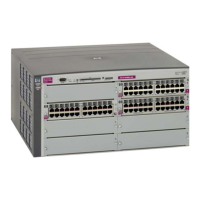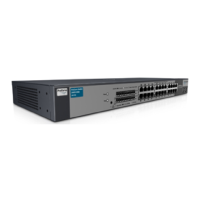RSTP and MSTP 62
RSTP and MSTP
Introduction
Rapid Spanning Tree Protocol (IEEE 802.1w) enhances the Spanning Tree Protocol (IEEE 802.1d) to provide rapid
convergence on Spanning Tree Group 1. Multiple Spanning Tree Protocol (IEEE 802.1s) extends the Rapid Spanning
Tree Protocol to provide both rapid convergence and load balancing in a VLAN environment.
The following topics are discussed in this chapter:
• Rapid Spanning Tree Protocol (RSTP)
• Multiple Spanning Tree Protocol (MSTP)
Rapid Spanning Tree Protocol
Rapid Spanning Tree Protocol (RSTP) provides rapid convergence of the spanning tree and provides for fast
reconfiguration critical for networks carrying delay-sensitive traffic such as voice and video. RSTP significantly reduces
the time to reconfigure the active topology of the network when changes occur to the physical topology or its
configuration parameters. RSTP reduces the bridged-LAN topology to a single Spanning Tree.
For more information about Spanning Tree Protocol, see the “Spanning Tree Protocol” chapter in this guide.
RSTP parameters are configured in Spanning Tree Group 1. STP Groups 2-128 do not apply to RSTP, and must be
cleared. There are new STP parameters to support RSTP, and some values to existing parameters are different.
RSTP is compatible with devices that run 802.1d Spanning Tree Protocol. If the switch detects 802.1d BPDUs, it
responds with 802.1d-compatible data units. RSTP is not compatible with Per VLAN Spanning Tree (PVST) protocol.
Port state changes
The port state controls the forwarding and learning processes of Spanning Tree. In RSTP, the port state has been
consolidated to the following: discarding, learning, and forwarding.
Table 13 RSTP vs. STP port states
Port operational status STP port state RSTP port state
Enabled Blocking Discarding
Enabled Listening Discarding
Enabled Learning Learning
Enabled Forwarding Forwarding
Disabled Disabled Discarding
Port type and link type
Spanning Tree Configuration includes the following parameters to support RSTP and MSTP:
• Edge port
• Link type
Although these parameters are configured for Spanning Tree Groups 1-128 (/cfg/l2/stp x/port x), they only
take effect when RSTP/MSTP is turned on.
Edge port
A port that connects to a server or stub network is called an edge port. Therefore, ports 1-16 should have edge
enabled. Edge ports can start forwarding as soon as the link is up.
Edge ports do not take part in Spanning Tree, and should not receive BPDUs. If a port with edge enabled does
receive a BPDU, it begins STP processing until it is re-enabled.
